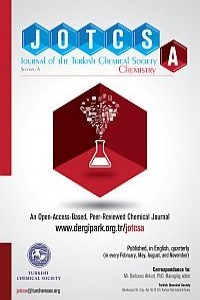Comparison of Four Different Polymeric Adsorbents as Clean-up Agents for Pesticide Analysis in Tea with LC MS/MS
Adsorption, QuEChERS, clean-up
Comparison of Four Different Polymeric Adsorbents as Clean-up Agents for Pesticide Analysis in Tea with LC MS/MS
___
- 1. Li X, Zhang Z, Li P, Zhang Q, Zhang W, Ding X. Determination for major chemical contaminants in tea (Camellia sinensis) matrices: A review. Food Research International. 2013 Oct;53(2):649–58.
- 2. Rutkowska E, Łozowicka B, Kaczyński P. Modification of Multiresidue QuEChERS Protocol to Minimize Matrix Effect and Improve Recoveries for Determination of Pesticide Residues in Dried Herbs Followed by GC-MS/MS. Food Anal Methods. 2018 Mar;11(3):709–24.
- 3. Zhang C, Suen CLC, Yang C, Quek SY. Antioxidant capacity and major polyphenol composition of teas as affected by geographical location, plantation elevation and leaf grade. Food Chemistry. 2018 Apr;244:109–19.
- 4. Pang GF, Fan CL, Cao YZ, Yan F, Li Y, Kang J, et al. High Throughput Analytical Techniques for the Determination and Confirmation of Residues of 653 Multiclass Pesticides and Chemical Pollutants in Tea by GC/MS, GC/MS/MS, and LC/MS/MS: Collaborative Study, First Action 2014.09. Journal of AOAC INTERNATIONAL. 2015 Sep 1;98(5):1428–54.
- 5. Guan Y, Tang H, Chen D, Xu T, Li L. Modified QuEChERS method for the analysis of 11 pesticide residues in tea by liquid chromatography–tandem mass spectrometry. Anal Methods. 2013;5(12):3056.
- 6. Hayward DG, Wong JW, Park HY. Determinations for Pesticides on Black, Green, Oolong, and White Teas by Gas Chromatography Triple-Quadrupole Mass Spectrometry. J Agric Food Chem. 2015 Sep 23;63(37):8116–24.
- 7. Hou X, Lei S, Guo L, Qiu S. Optimization of a multi-residue method for 101 pesticides in green tea leaves using gas chromatography-tandem mass spectrometry. Revista Brasileira de Farmacognosia. 2016 Jul;26(4):401–7.
- 8. Zhao HX, Zhao SC, Deng LG, Mao JS, Guo CY, Yang GS, et al. Rapid Determination of Organonitrogen, Organophosphorus and Carbamate Pesticides in Tea by Ultrahigh-Performance Liquid Chromatography–Tandem Mass Spectrometry (UPLC-MS/MS). Food Anal Methods. 2013 Apr;6(2):497–505.
- 9. Wu CC. Multiresidue method for the determination of pesticides in Oolong tea using QuEChERS by gas chromatography-triple quadrupole tandem mass spectrometry. Food Chemistry. 2017 Aug;229:580–7.
- 10. Saito-Shida S, Nemoto S, Teshima R. Multiresidue determination of pesticides in tea by gas chromatography-tandem mass spectrometry. Journal of Environmental Science and Health, Part B. 2015 Nov 2;50(11):760–76.
- 11. Liu X, Guan W, Hao X, Wu X, Ma Y, Pan C. Pesticide Multi-Residue Analysis in Tea Using d-SPE Sample Cleanup with Graphene Mixed with Primary Secondary Amine and Graphitized Carbon Black Prior to LC–MS/MS. Chromatographia. 2014 Jan;77(1–2):31–7.
- 12. Hou X, Lei S, Qiu S, Guo L, Yi S, Liu W. A multi-residue method for the determination of pesticides in tea using multi-walled carbon nanotubes as a dispersive solid phase extraction absorbent. Food Chemistry. 2014 Jun;153:121–9.
- 13. Rejczak T, Tuzimski T. QuEChERS-based extraction with dispersive solid phase extraction clean-up using PSA and ZrO2-based sorbents for determination of pesticides in bovine milk samples by HPLC-DAD. Food Chemistry. 2017 Feb;217:225–33.
- 14. Cao Y, Tang H, Chen D, Li L. A novel method based on MSPD for simultaneous determination of 16 pesticide residues in tea by LC–MS/MS. Journal of Chromatography B. 2015 Aug;998–999:72–9.
- 15. Sun X, Luo J, Lu Q, Li C, Zhao Z, An F, et al. Application of hydroxylated multi-walled carbon nanotubes as depigmentation agent in the determination of multiple pesticide residues in Lonicerae japonicae flower buds. Microchemical Journal. 2022 Jun;177:107280.
- 16. Zhao WH, Shi YP. A porous boron nitride nanorods-based QuEChERS analysis method for detection of five neonicotinoid pesticide residues in goji berries. Journal of Chromatography A. 2022 May;1670:462968.
- 17. Meng X, Song W, Xiao Y, Zheng P, Cui C, Gao W, et al. Rapid determination of 134 pesticides in tea through multi-functional filter cleanup followed by UPLC-QTOF-MS. Food Chemistry. 2022 Feb;370:130846.
- 18. Guo J, Tong M, Tang J, Bian H, Wan X, He L, et al. Analysis of multiple pesticide residues in polyphenol-rich agricultural products by UPLC-MS/MS using a modified QuEChERS extraction and dilution method. Food Chemistry. 2019 Feb;274:452–9.
- 19. Ahmad A, Siddique JA, Laskar MA, Kumar R, Mohd-Setapar SH, Khatoon A, et al. New generation Amberlite XAD resin for the removal of metal ions: A review. Journal of Environmental Sciences. 2015 May;31:104–23.
- 20. Kyriakopoulos GG, Hourdakis AA, Doulia DD. Adsorption of Pesticides on Resins. Journal of Environmental Science and Health, Part B. 2003 Mar;38(2):157–68.
- 21. Rajski Ł, Lozano A, Belmonte-Valles N, Uclés A, Uclés S, Mezcua M, et al. Comparison of three multiresidue methods to analyse pesticides in green tea with liquid and gas chromatography/tandem mass spectrometry. Analyst. 2013;138(3):921–31.
- 22. Jiao W, Xiao Y, Qian X, Tong M, Hu Y, Hou R, et al. Optimized combination of dilution and refined QuEChERS to overcome matrix effects of six types of tea for determination eight neonicotinoid insecticides by ultra performance liquid chromatography–electrospray tandem mass spectrometry. Food Chemistry. 2016 Nov;210:26–34.
- Başlangıç: 2014
- Yayıncı: Türkiye Kimya Derneği
Ghufran A. ALHAMMADİ, Lamya A. SARSAM
Nisreen Jassam ALAALLAH, Ekhlas ABD ALKAREEM, Aseel GHAİDAN, Nuha A. IMRAN
Sabtanti HARİMURTİ, Angelina MAWARNİ, Ika Sevi DERİYANTİ, Hari WİDADA, Dyani Primasari SUKAMDİ
Production of Biodiesel from Waste Cooking Oil Using KOH/Al2O3 as a Heterogeneous Catalyst
Ibrahim Yaagoub ERWA, Asmo HASSAN, Razan SALİM, Omer ISHAG, Maysoon AHMED
